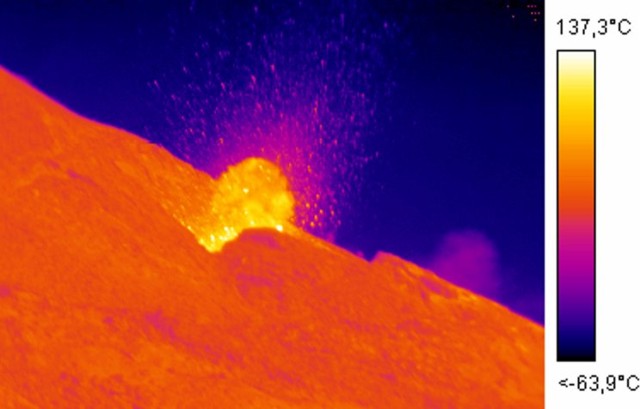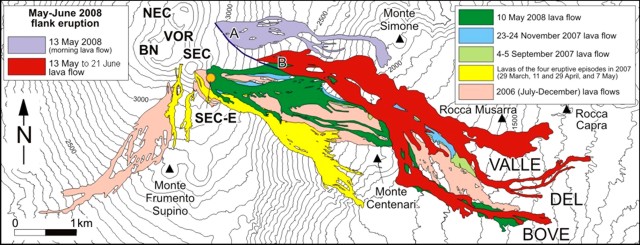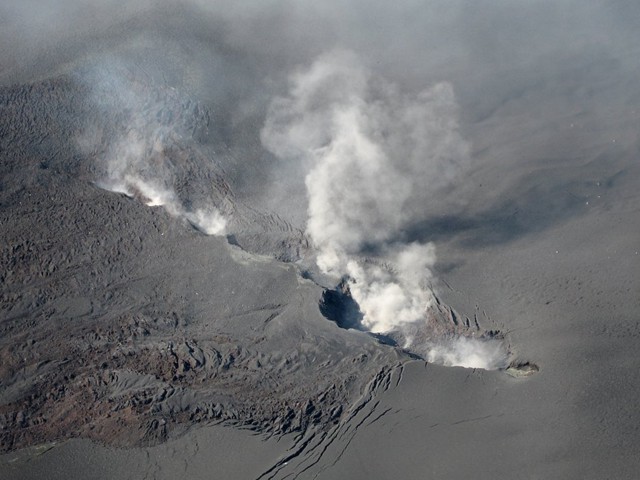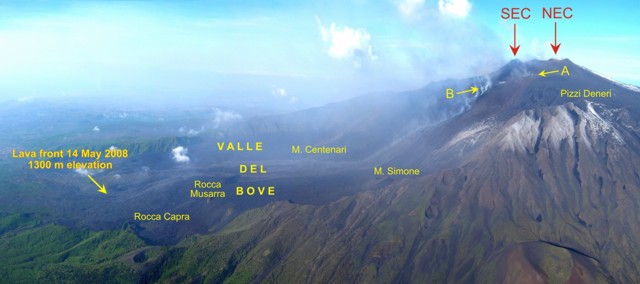Report on Etna (Italy) — May 2008
Bulletin of the Global Volcanism Network, vol. 33, no. 5 (May 2008)
Managing Editor: Richard Wunderman.
Etna (Italy) 6-km-long lava flow; ash emissions; 13 May 2008 opening of a new eruptive fissure
Please cite this report as:
Global Volcanism Program, 2008. Report on Etna (Italy) (Wunderman, R., ed.). Bulletin of the Global Volcanism Network, 33:5. Smithsonian Institution. https://doi.org/10.5479/si.GVP.BGVN200805-211060
Etna
Italy
37.748°N, 14.999°E; summit elev. 3357 m
All times are local (unless otherwise noted)
After several months of eruptive activity at the summit craters, on 13 May a new eruptive fissure opened between 3,050 and 2,650 m elevation on Etna's upper E side, feeding lava flows into the Valle del Bove (figure 132). This took place without threatening inhabited areas. It was preceded by several months of sporadic ash emissions, a brief period of Strombolian activity, and a powerful eruptive phase from Southeast Crater (SEC) on 10 May. As of 20 June, modest Strombolian activity continued from two vents along the fissure at approximately 2,800 m elevation, accompanied by lava emission from a third vent, with lava advancing ~ 5 km to the E.
This report was compiled from contributions by the staff of the Istituto Nazionale di Geofisica e Vulcanologia, sezione di Catania (INGV-CT), which are available as pdf files on the Institute's website (see Information Contacts).
Activity during January-April 2008. During this time interval, periodic emissions of ash occurred from a vent located on the E flank of the SEC cone (hereafter named SEC-E), which had been the site of two strong eruptive episodes on 4-5 September and 23-24 November 2007 (see BGVN 32:08, 32:09 and 33:01). This activity apparently ejected mostly lithic ash, and no incandescence was seen through mid-April. A period of weak Strombolian activity occurred between 23 and 28 April (figure 133), when explosions ejected incandescent bombs up to 100 m above the vent, and some material fell to the base of the SEC cone. The area was quiet between 29 April and 10 May.
 |
Figure 133. Thermal camera image of a Strombolian explosion from the active eastern vent of the Southeast Crater (SEC-E) on 23 April 2008. Courtesy of INGV-CT. |
Event of 10 May 2008. A sharp increase in the volcanic tremor amplitude at 1400 UTC on 10 May announced the onset of a new paroxysmal eruptive episode at the SEC. Observation was difficult, due to inclement weather conditions. During the first stages of activity, eyewitnesses in the summit area observed explosive activity at several locations within and around SEC-E, and lava overflows feeding several branches of lava toward the Valle del Bove (figure 134). While lava descended very rapidly into the Valle del Bove, explosive interaction with patches of remaining snow repeatedly occurred along the path of the lava flows. The lava advanced across the Valle del Bove floor toward Monte Calanna down to an elevation of ~ 1,370 m, reaching a total length of 6.4 km from its source. This is one of the longest lava flows fed by a summit eruption of Etna in recorded history. A preliminary estimate of the lava volume yields ~ 4.5 x 106 m3, which was emitted at peak rates exceeding 300 m3/s (in comparison, peak eruption rates calculated for the violent fire-fountaining episodes at the SEC in 2000 were consistently below 200 m3/s; Behncke et al. 2006). Tephra fallout occurred mostly to the N and later to the NE (Andronico et al. 2008). The activity came to an abrupt halt at about 1800, after which no appreciable activity occurred for the following 2.5 days. Figure 134 is an aerial view of the SEC with its SEC-E vent, taken during a period of complete quiescence on 28 May.
Start of flank eruption, 13 May 2008. The intrusion of a dike into the upper portions of the Etna's edifice was marked by a seismic swarm starting at 0840 UTC (Unit? Funzionale Sismologia, 2008). Eruptive activity started from a fissure segment ("A" in figures 132 and 136 and shown close-up in figure 135) located roughly at 3,000 m elevation at the E base of the Northeast Crater (NEC) cone, where fire-fountaining produced a thick scoria deposit and generated sheet flows 2.5 km E toward Monte Simone. This activity probably lasted only a few hours and was followed by the propagation of new fissures to the SE ("B" in figures 132 and 136), down to an elevation of ~ 2,650 m, into the Valle del Leone, in the opposite direction of the initial dike intrusion, which apparently came to a halt during the early afternoon.
Visual observations were severely hampered by poor weather conditions, but heavy scoria falls were noted on the N flank during the early afternoon, and satellite imagery showed a narrow plume extending NNE (Coltelli et al. 2008). INGV staff visiting the summit area later that day stated that explosive activity occurred from multiple vents along an eruptive fracture to the E of the summit, and lava was flowing toward the Valle del Bove. Fieldwork carried out during the following days revealed that an extensive fracture field had formed around the NEC and beyond toward the upper N flank of Etna (Neri, 2008).
Continuing activity, 14 May to present. Improved weather conditions on 14 and 15 May permitted the first overviews of the eruption area (figure 136), and revealed that lava flows from the still active fissure segment at ~ 2,700-2,800 m elevation had descended approximately 6 km to 1,300 m elevation, but movement of the lava flow fronts had slowed significantly. Intense Strombolian activity occurred from a number of vents, and lava issued from at least two main locations. The uppermost fissure segment, first active on the morning of 13 May, showed little activity except for degassing and occasional emissions of dilute ash plumes. Ash was also emitted periodically from SEC-E.
On 16 and 17 June, ash emissions from that vent became more vigorous, and ash was also emitted from several vents in the upper portion of the still-active fissure segment on the upper E flank. The active lava flows, however, showed a significant reduction in their length compared to the first few days of eruption. During the following days, the ash emissions at the SEC stopped, and activity at the E flank fissure showed a marked diminution. Throughout late May and into early June, Strombolian activity was confined to one or two vents at about 2,800 m elevation, and lava emission from a single vent located a few tens of meters downslope fed small flow lobes that advanced to ever decreasing distances, reaching a minimum of ~ 0.4 km on 4 June.
A gradual but clear increase in the volcanic tremor amplitude and changes in the gas geochemistry heralded a revival of both the explosive and effusive activity on 8 June, which created a fresh surge of lava into the Valle del Bove. On 18 June, little more than one month after the start of the flank eruption, the lava fronts reached an elevation of about 1,350 m between Rocca Musarra and Rocca Capra (figure 132) and a distance of 5 km from the vents. Mild Strombolian activity continued from two vents located at ~ 2,800 m elevation.
After extending 5 km down through the Valle del Bove in mid-June, lava flows remained much shorter until the last few days of the month, when a new lobe advanced 4.8 km E, somewhat southward of the mid-June lava lobe. The late-June lobe was seen stagnant on 1 July. On the afternoon of 4 July, ash emissions from a point of the eruptive fissure upslope from the recently active vents (at 2,800 m elevation) marked the reactivation of a vent that had been inactive since mid-May. Vigorous Strombolian activity occurred from this vent during the following days, alternating with periods of ash emission. As of 6 July, lava was traveling further S, extending less than 4 km from the vents.
References. Andronico, D., Coltelli, M., Cristaldi, A., Lo Castro, D., and Scollo, S., 2008, Il parossismo del 10 maggio 2008 al Cratere di SE: caratteristiche del deposito di caduta (URL: http://www.ct.ingv.it/Report/RPTVETCEN20080510.pdf).
Behncke, B., Neri, M., Pecora, E., and Zanon, V., 2006, The exceptional activity and growth of the Southeast Crater, Mount Etna (Italy), between 1996 and 2001: Bulletin of Volcanology, v. 69, p. 149-173.
Budetta, G., Ciraudo, A., Currenti, G., Del Negro, C., Ganci, G., Greco, F., Herault, A., Napoli, R., Scandura, D., Sicali, A., and Vicari, A., 2008, Aggiornamento dello stato di attivit? dell'Etna: Osservazioni gravimetriche e magnetiche, (URL: http://www.ct.ingv.it/Report/UFGMET20080513.pdf ).
Coltelli, M., Prestifilippo, M., Scollo, S., and Spata, G., 2008, Rapporto tecnico del 13 Maggio 2008 ? Osservazione da satellite e simulazione dell'emissione di cenere (URL: http://www.ct.ingv.it/Report/Rapporto_UPNV_CT_ 20080513.pdf )
Neri, M., 2008, Eruzione dell'Etna: Fratture non eruttive sul fianco settentrionale del Cratere di Nord-Est; Aggiornamento al 28 Maggio 2008 (URL: http://www.ct.ingv.it/Report/RPTVGSTR20080528.pdf ).
Puglisi, G., Gambino, S., Mattia, M., and Aloisi, M., 2008, Monitoraggio Geodetico delle Deformazioni del suolo all'Etna: Aggiornamento 14 maggio 2008 ? 09:00 (URL: http://www.ct.ingv.it/Report/UFDG-RA_2008-08.pdf ).
Unit?Funzionale Sismologia (edited by D. Patanè), 2008, Quadro di sintesi e aggiornamento al 19 Maggio 2008 sullo stato di attivit?sismica dell'Etna (URL: http://www.ct.ingv.it/Report/REPUFS20080519.pdf ).
Geological Summary. Mount Etna, towering above Catania on the island of Sicily, has one of the world's longest documented records of volcanism, dating back to 1500 BCE. Historical lava flows of basaltic composition cover much of the surface of this massive volcano, whose edifice is the highest and most voluminous in Italy. The Mongibello stratovolcano, truncated by several small calderas, was constructed during the late Pleistocene and Holocene over an older shield volcano. The most prominent morphological feature of Etna is the Valle del Bove, a 5 x 10 km caldera open to the east. Two styles of eruptive activity typically occur, sometimes simultaneously. Persistent explosive eruptions, sometimes with minor lava emissions, take place from one or more summit craters. Flank vents, typically with higher effusion rates, are less frequently active and originate from fissures that open progressively downward from near the summit (usually accompanied by Strombolian eruptions at the upper end). Cinder cones are commonly constructed over the vents of lower-flank lava flows. Lava flows extend to the foot of the volcano on all sides and have reached the sea over a broad area on the SE flank.
Information Contacts: Boris Behncke and Sonia Calvari, Istituto Nazionale di Geofisica e Vulcanologia, Sezione di Catania, Piazza Roma 2, 95123 Catania, Italy (URL: http://www.ct.ingv.it/).





